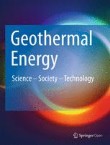Associated Societies
Geothermal energy from the Main Karoo Basin? New insights from borehole KWV-1 (Eastern Cape, South Africa)
Deep sedimentary basins are currently being assessed globally with respect to their geothermal energy resources. So far, the utilization of deep geothermal energy has not been addressed or included in any rene...
